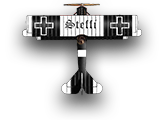I have been a very casual gamer with very little time for gaming since I started playing WOW/WOG several years ago. I typically have only played with the Basic and Standard Rules for ease of play since I didn't play much and didn't have a regular group of players to play with.
Now that things have changed for the better this year, I am now consistently playing at least once every 4-6 weeks and have several players who are regularly joining my gaming sessions, we plan to add in the altitude rules. After my review of the WWI altitude rules, I would appreciate assistance with a few questions!
Assuming we are playing with the standard (4-peg) WWI altitude rules.
Q: What is the maximum number of climb counters that can be gained in one three card turn?
A: One climb counter per turn (via climb card or Immelmann Turn). The Immelmann Turn can not be executed in the same turn as a climb per the official Ares WGF FAQ (for Page 15 of the Rules and Accessories Pack Rulebook).
Q: What is the maximum number of climb counters or pegs (to decrease "altitude") in one three card turn?
A: One per turn. A Split-S can not be executed the same turn as a dive (per Page 15 of the Rules and Accessories Pack Rulebook). A dive card decreases altitude by one peg and removes all climb counters. A Split-S removes a climb counter or may decrease altitude (if executed with no climb counters).
Q: What happens when an Immelmann Turn is executed when a plane is already at maximum altitude (i.e. 4 pegs, not playing with Flying Higher Optional Rule)?
A: Nothing. I am NOT a fan of "house rules", but it seems this hasn't been addressed in the rules. My recommendation is that the Immelmann Turn may be executed, but without adding a climb counter. The rulebook states that a Split-S executed at Altitude 1 with no climib counters, it crashes to the ground and is eliminated (per Page 15 of the Rules and Accessories Pack Rulebook).








 Reply With Quote
Reply With Quote


 I understand your explanation for #2. I also like your Basic Rules illegal maneuver penalty idea for the Immelmann at maximum atitude (4-peg rules) for #3 (vs. no penalty).
I understand your explanation for #2. I also like your Basic Rules illegal maneuver penalty idea for the Immelmann at maximum atitude (4-peg rules) for #3 (vs. no penalty). 












Bookmarks